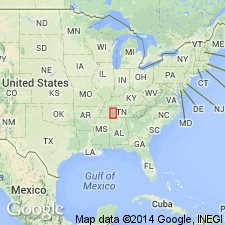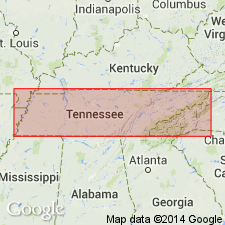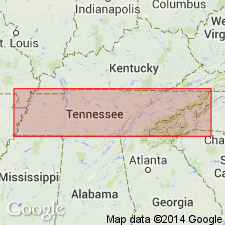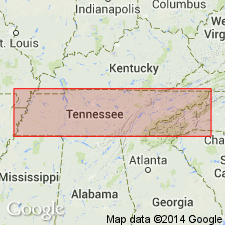
- Usage in publication:
-
- Pyburn limestone
- Modifications:
-
- Named
- Dominant lithology:
-
- Limestone
- AAPG geologic province:
-
- Cincinnati arch
Summary:
Linden bed divided into a lower CAMAROCRINUS or Ross limestone and an upper Pyburn limestone. Upper half appears to contain a greater quantity of softer, clayey material, which weathers readily. Linden bed fossils may be collected free from the rock at many exposures. The outcrops at Perryville, Linden, and Cumberland City appear to belong to upper or Pyburn horizon, which seems to have a greater eastward extension than the lower Ross limestone.
Source: GNU records (USGS DDS-6; Reston GNULEX).

- Usage in publication:
-
- Pyburn beds
- Modifications:
-
- Overview
- Dominant lithology:
-
- Limestone
- Shale
- AAPG geologic province:
-
- Cincinnati arch
Summary:
Pyburn beds of Foerste consist of blue shales and thin limestones overlying Ross bed.
Source: GNU records (USGS DDS-6; Reston GNULEX).

- Usage in publication:
-
- Pyburn limestone member
- Modifications:
-
- Revised
- AAPG geologic province:
-
- Cincinnati arch
Summary:
Pyburn limestone member of Olive Hill formation is thin-bedded impure, dirty and cherty limestone with occasional bands of chert 2 to 10 in. thick. Lower part somewhat softer, but upper 14 ft or more is heavy-bedded and lithologically closely resembles underlying Ross limestone. Occupies more or less the stratigraphic position of Bear Branch member of Olive Hill formation, but lithology is distinctly different and they occur in different regions, so that both names will be useful. Report contains detailed section at Pyburn Bluff where unit is 43.5 ft thick and disconformably underlies Hardin sandstone. [Note in GNU files states that this definition of the Pyburn was adopted for usage by the USGS on Feb. 27, 1928, by Butts, Miser, and Stanton "for the present at least."]
Source: GNU records (USGS DDS-6; Reston GNULEX).

- Usage in publication:
-
- Pyburn limestone†
- Modifications:
-
- Abandoned
- AAPG geologic province:
-
- Cincinnati arch
Summary:
Pg. 288. †Pyburn limestone. Use of the name, Pyburn limestone, is discontinued and all limestone formerly classed as Pyburn is included in [/]Ross limestone member of [/]Ross formation (new).
[Name Ross preempted by Ross Limestone of Foerste (1903), which = Ross limestone member of author. The application of an identical geographic name to a stratigraphic unit and its parts (Ross limestone member of Ross formation) conflicts with nomenclature guidelines (CSN, 1933; ACSN, 1961, 1970; NACSN, 1983, 2005, 2021). Precise duplication of geographic names of sedimentary units shall not be allowed, except as a most urgent necessity because of scarcity of available names or other conditions, and then only if geographic and stratigraphic separation is such as to preclude any possible chance of confusion (CSN, 1933).]
Source: Modified from US geologic names lexicon (USGS Bull. 1200, p. 3165).
For more information, please contact Nancy Stamm, Geologic Names Committee Secretary.
Asterisk (*) indicates published by U.S. Geological Survey authors.
"No current usage" (†) implies that a name has been abandoned or has fallen into disuse. Former usage and, if known, replacement name given in parentheses ( ).
Slash (/) indicates name conflicts with nomenclatural guidelines (CSN, 1933; ACSN, 1961, 1970; NACSN, 1983, 2005, 2021). May be explained within brackets ([ ]).

